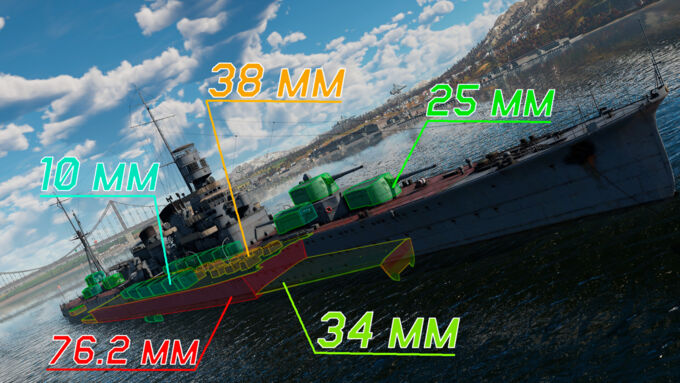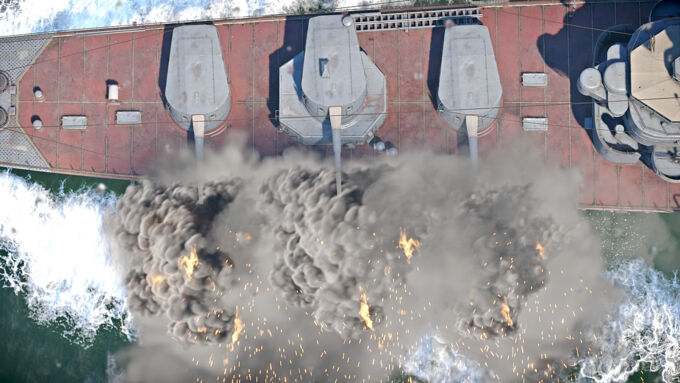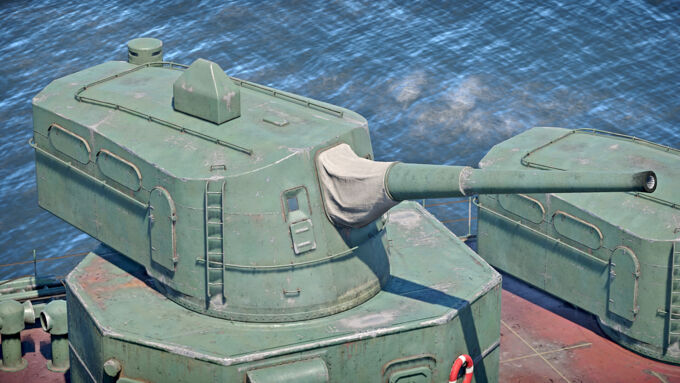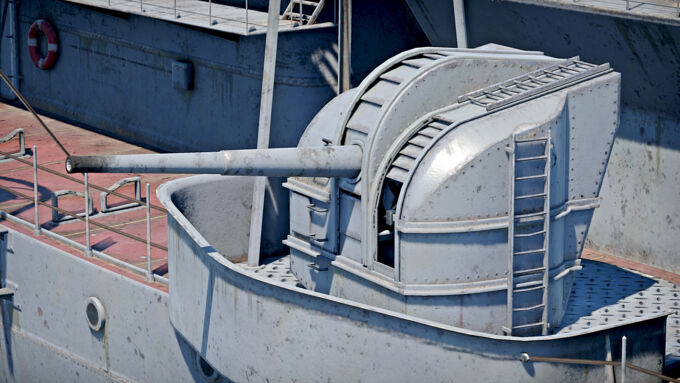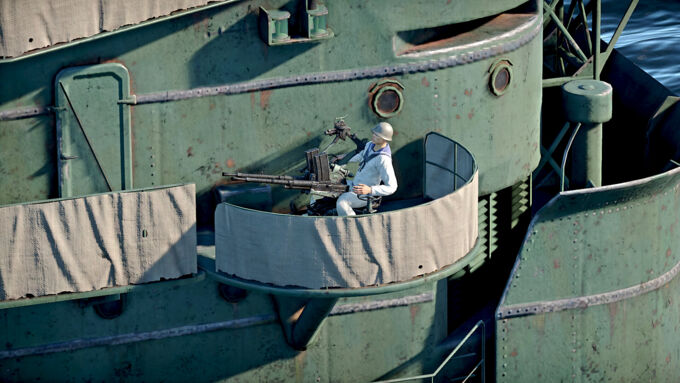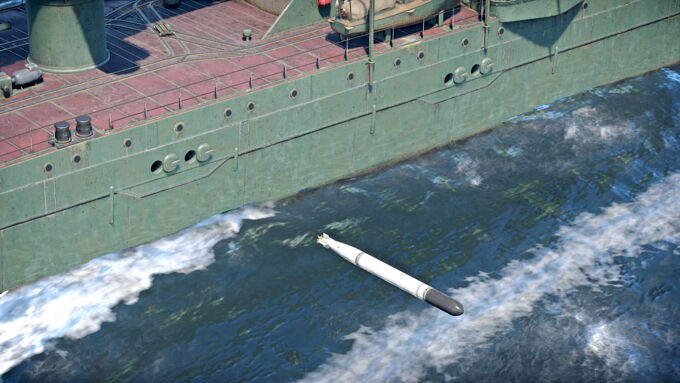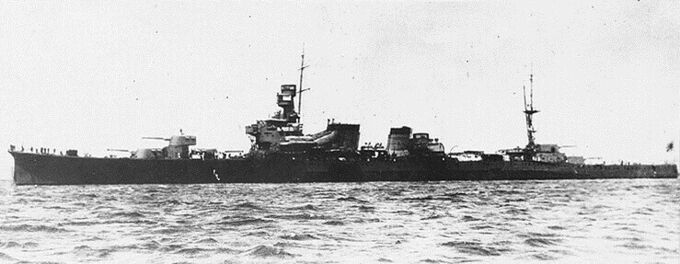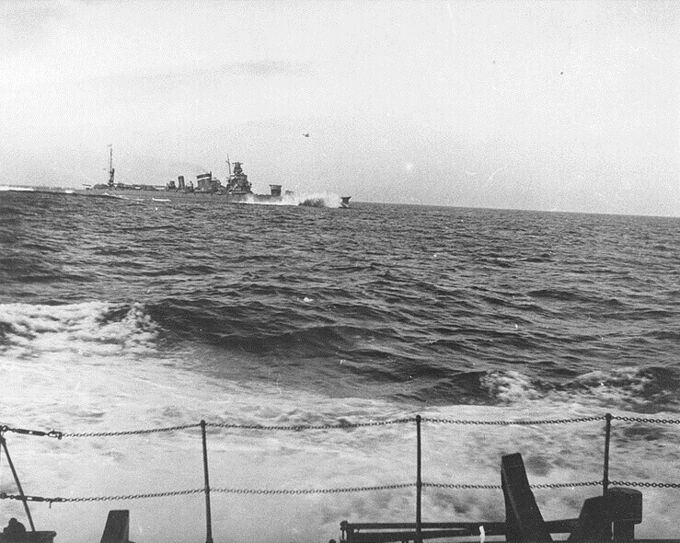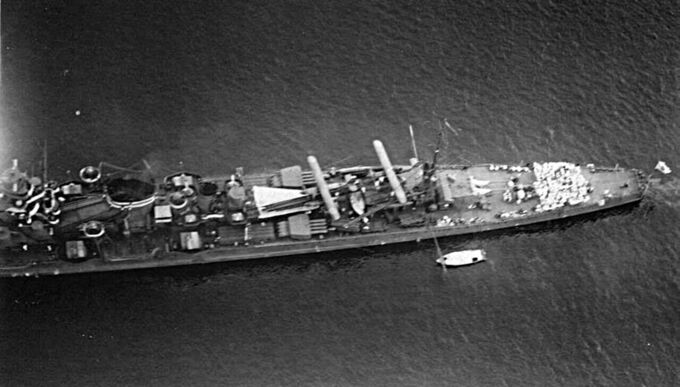Kako (加古, named after the Kako river in Hyogo Prefecture) was a heavy cruiser of the Imperial Japanese Navy of the Furutaka class. In fact, cruisers of this class were designed as “first-class cruisers”, since at the time of their construction, the term “heavy cruiser” (which was later defined in the Washington Naval Treaty of 1922) did not exist. The cruiser is characterized by a powerful main battery and good survivability, but suffers from a lack of anti-air armament and weak secondary armament.
| Advantages | Disadvantages |
|---|---|
| Powerful main battery | Long main battery reload |
| Good armor | Mediocre secondary armament |
| Great mobility | Weak anti-aircraft armament |
Armor and survivability
The cruiser's 76.2 mm thick main belt covers the boiler rooms from the sides, which is protected above by a deck of thickness from 31.75 mm to 35 mm, and from the stern and bow is enclosed by 76.2 mm thick armored bulkheads. Also on the sides, above the armor deck, are the coal bunkers, which give minor protection equivalent to 10 mm of armor. The main battery magazines are not protected from the sides, but they are below the waterline and also protected from the front by a transverse of thickness from 38 to 63.5 mm, as well as covered from above by a 34 mm thick armored deck. There is no protection of the bridge. Protection of the main battery turrets is mediocre — 25 mm in front and from the sides and 6.5 mm from behind. There is no anti-torpedo protection.
IJN Kako generally survives duels with light cruisers and destroyers quite well. Detonation of magazines is very difficult to cause — mostly it happens only due to fires in the main battery turrets. Despite the fact that the crew is located inside the armored citadel, it's worth noting that it dwindles rather quickly, mostly because of poorly protected gun mounts, both main and secondary armament. But Kako can escape from under fire quite easily due to its good mobility.
Mobility
The cruiser's dynamic characteristics makes it one of the best in its class in terms of mobility. In their aggregate, it surpasses almost all of its opponents. Speed: 76 km/h (41 knots) forward and 21 km/h (11 knots) astern in AB, and 65 km/h (35 knots) forward and 18 km/h (9.7 knots) astern in RB, which is slightly above the class average. In particular, the cruiser's performance is far superior to her British vis-a-vis, the Hawkins-class cruiser, and slightly better than the American Northampton-class cruiser. Kako is also faster than Omaha-class cruisers (for example USS Raleigh), which she was designed to counter, but is inferior to them in astern speed. In addition, the ship is very easy to turn and very fast to gain speed, which also demonstrates its superiority over its opponents.
Armament
Main battery
The main battery is represented by six Type A single gun mounts with 200 mm Type 3 (No. 1) guns, arranged pyramidally with three each fore and aft.
There are two projectiles to choose from:
- High-explosive fragmentation shell — 870 m/s, 110 kg/7.3 kg Shimose (TNT equivalent 8.03 kg), armor penetration - 60 mm at all ranges;
- Armor-piercing capped ballistic capped shell — 870 m/s, 110 kg/2.84 kg Shimose (TNT equivalent 3.12 kg), armor penetration — 349 mm at 1000 m, 305 mm @ 2.5 km, 243 mm @ 5 km;
The guns are quite powerful, but due to the peculiarity of their location — in single-gun mounts — they're characterized by a very large dispersion when firing salvos. Also the guns are characterized by very low rate of fire — with ace-level crew skills it's only one shot in 15 seconds. Moreover, when the first-order ammunition is used up, the reloading time increases to 22 seconds. The speed of guidance of installations is also quite low — only 6°/s vertically and 4 °/s horizontally. However, the disadvantages of these guns are offset by their destructive power — it is quite enough to annihilate a destroyer in one salvo or to inflict extremely serious damage to a light cruiser.
Secondary armament
The secondary armament is represented by four single-gun Type B2 shielded mounts with 120 mm/45 Type 10 guns.
The gun has two projectiles:
- High-explosive fragmentation shell — 850 m/s, 20.33 kg/1.86 kg Type 91 explosive (TNT equivalent 1.95 kg), armor penetration — 24 mm at all ranges;
- High-explosive shell with time fuze — similar characteristics.
The problem with secondary armament is mainly its small amount. Often guns do not create the necessary fire density, and they are also not very accurate. This battery can shoot down a bomber or attack aircraft flying at medium altitude before it gets into a bombing position, but only if it is flying in a straight line.
Anti-aircraft armament
Cruiser's anti-aircraft armament is represented by two twin mounts of 13.2 mm Type 93 machine guns located on the bridge sponsons. This armament is extremely insufficient. The firepower of these machine guns is only enough to shoot down a small attack aircraft on a strafing run next to the ship, so that an experienced pilot will still have time to drop bombs. Also the firing arcs of these mounts are such that together they can only shoot at the bow, but only one mount can operate on the sides. Therefore, on this cruiser it is better to stay close to allies with good AA armament.
Additional armament
A consequence of the tactical preferences of the Naval General Staff was the powerful torpedo armament. The Kako is equipped with 6 twin torpedo tubes with 610 mm Type 8 No. 2 wet-heater torpedoes and 12 spares for a total of 24 torpedoes onboard. The torpedoes themselves are quite good — they can travel 20 km at 50 km/h and have a warhead weighing 346 kg Shimose (380.6 kg TNT equivalent). However, the location of torpedo tubes makes the use of this type of armament almost impossible — torpedo tubes are rigidly fixed under the upper deck, so to launch torpedoes the cruiser must turn broadside to the enemy, which can have a very negative impact on the survivability of the ship. Therefore, torpedoes on this cruiser can only be used as a last-resort weapon.
Scout plane
The cruiser is equipped with a very good E7K2 reconnaissance aircraft. This aircraft dynamic characteristics are not great not terrible, but it is easy enough to take off from the water, and also it carries four 60 kg Type 97 No. 6 high-explosive bombs and has two machine guns.
Combat usage
The cruiser is very good in encounters against destroyers and light cruisers. Its guns are powerful enough to annihilate a destroyer or light cruiser with a single salvo or at least do serious damage to it — for example, they're pretty good against Porter-class destroyers or Omaha-class light cruisers, as well as against some German Leipzig-class cruisers. However, Kakos' guns may be ineffective against more heavily armored targets such as Italian heavy cruisers (for example RN Pola or RN Bolzano) or German Admiral Hipper-class heavy cruisers. Torpedoes on this cruiser are more about last-resort weapon. Sometimes they can be useful, for example in close-range battles with many covers, but the difficulty of their use due to the location of torpedo tubes leaves a very few options.
Moreover, Kako often easily outruns the attacking forces and breaks into the rearguard of the advancing forces due to its great mobility. However, this should not be done — this cruiser has extremely weak anti-aircraft armament, and can quickly die from bombs, as well as by fire from fast-firing destroyers — for example, American “Porter” or “Gearing” classes. The cruiser can fight alone, but it will not be able to show much effectiveness in this situation. It is important to stay within a formation with allies and benefit from their fire anti-air cover. In this case, IJN Kako will show its best side.
History
Design and construction
Source
The Furutaka-class cruisers were initially designed as scout cruisers, fast but at the same time quite heavily armed. The cruisers were originally intended to be armed with 140 mm guns, but by 1921 prototypes of new 200 mm guns designed by Dr. Chiyokichi Hata were ready, which satisfied the Naval General Staff and were adopted as Type 3. At the same time, the new head of the Main Design Division of the Shipbuilding Section of the Navy's Technical Committee, shipbuilder Captain Yuzuru Hiraga, proposed a completely new design for a 7,500-ton cruiser carrying six new guns in single half-towers arranged in a diametrical plane, which gave an almost double advantage in onboard salvo weight over their intended opponents, the Omaha- and Hawkins-class cruisers.
This enhancement of armament together with the reduction of displacement was possible due to the original solutions of Captain Hiraga to reduce weight, in particular, the side armor plates served not only as protection, but also were an element of the load-bearing structure. A new wave-shaped deck was also proposed, which later became a distinctive feature of almost all Japanese heavy cruisers.
Captain Hiraga convinced the naval general staff to replace the 8,000-ton cruisers of 1918 shipbuilding programm with his experimental designs of 7,500-ton cruisers. Detailed drawings of these new ships were prepared by the summer of 1921. Thus the Furutaka class was born.
In commission
After commissioning on July 20, 1926, Kako was assigned to naval base Yokosuka and given the call sign JJAA. On August 1, it became the flagship of the 5th Division (one mark on the tubes), succeeding her sister ship IJN Furutaka in that role (in addition to them, the division also had the 5,500-ton cruiser IJN Sendai). On December 1, the Naka and Jintsu joined, replacing the Sendai and Natori.
In the summer of 1927, the 5th Division took part in large fleet maneuvers. On August 5, at the demonstration firing Kako shot the decommissioned cruiser Chiyoda. Since December 1 of the same year, all light cruisers of the Sendai class were withdrawn from the division, and their place was taken by new heavy cruisers — the sister ships Kinugasa and Aoba, with first one as the flagship.
On April 19, 1928, the 5th Division moved to Qingdao to cover the to cover the landing of japanese troops. In the fall of 1928 Kako together with the division participated in regular maneuvers, and on December 4 — in the ceremonial review of the fleet in Yokosuka, timed to the coronation of Emperor Hirohito.
From July 24 to May 10, 1930 Kako underwent repairs at Yokosuka, during which work of the turbines and ventilation of the liquid fuel tanks were improved.
From December 1, 1930 Kako was put in reserve and from May 15 to September 19, 1931 passed drydocking in Yokosuka, and from November 10 to May 31, 1932 underwent the first major modernization at the shipyard in Kure. During the modernization the following works were carried out:
- Type 3 80 mm anti-aircraft guns were replaced by the more modern Type 10 45-caliber 120 mm guns. The guns were mounted in Type B2 twin gun mounts, rotated by electro-hydraulic motors. The guns were protected by 1.6-3.2 mm shields and weighed 10 tons. When guided by an electro-hydraulic motor, the horizontal turn rate was 10º/sec and the vertical turn rate was 6.5º/sec. Slower manual guidance was also provided for the mounts. Rate of fire was about 10 rounds per minute. Delivery of shells from the magazines weas carried out by a chain hoist, loading was manual. Fuze was also selected manually before firing.
- On the bridge, below the navigation platform on the sides sponsons were made, where two twin 13.2 mm Hotchkiss machine guns were installed.
- Two turrets were added on the sides from the forward pipe, on which were mounted Type 91 directors for the new Type 10 anti-aircraft guns.
- Also two 2-meter Barr and Stroud rangefinders for anti-aircraft weapons were mounted side-by-side on the bridge above the upper deck.
- A new Type 2 catapult was installed at the place of dismantled aircraft platform. The catapult was 19.4 m long and 1.2 m wide. The catapult could launch an aircraft weighing up to 2 tons at a speed of 26 m/s.
The ventilation system was also improved, new radio equipment was installed and the bridge platforms were slightly widened.
On December 1, 1932, Kako returned to the 5th Division along with Aoba and Kinugasa. In April 1933, they participated in maneuvers and firing exercises off Oshima Island at the target ship Haikan No. 2. On May 20, all three ships were transferred from the 5th to the 6th Division. From May 11 to June 10, 1933, Kako underwent drydocking at Kure, during which the ventilation of the central and aft torpedo bays was improved. On June 29, all three cruisers left Sasebo for the coast of South China, arrived at Mako on July 5, called at Takao on July 13, and returned to Tokyo Bay on August 21. There they participated in a naval review on August 25.
Reconstruction and pre-World War Two service
On December 11, 1933, Kako was once again placed in reserve. She underwent drydocking at Kure from November 10, 1934 to February 22, 1935 and from May 20 to July 30 of the same year, at which time the steam-driven steering wheel was replaced by an electro-hydraulic one. On July 4, 1936 the cruiser was put into dry dock for refit, which lasted until December 27, 1937.
The refit included an almost complete rebuilding of the ship:
- Six obsolete and not very well performing 200 mm Type A single mounts were being replaced by three twin 203 mm Type E2s;
- The Type 12 rigged torpedo tubes were replaced by two Type 92 quadruple tubes;
- Four twin mounts of 25 mm Type 96 anti-aircraft guns were added;
- The bow superstructure was completely rebuilt;
- Fire control systems were modernized;
- New catapult Type No. 2 Model 3 1st modification was installed;
- Anti-torpedo bulges and cheek keels were added, improving protection and stability.
On October 11, 1940, the cruiser as part of the ships of the 6th Division participated in a naval review in Yokohama, dedicated to the 2600th anniversary of the founding of the Japanese state by the legendary Emperor Jimmu.
On February 24, 1941 Kako, Furutaka and Aoba left Sasebo to the coast of South China, entered Mako and on March 3 returned to the Inland Sea. In June-August, the cruiser made trips off the coast of Japan, and September 5-14, together with Furutaka passed from Murodzumi to Kure, where she underwent scheduled repairs.
On October 5 to 7, the 6th Division went to the Murodzumi area for maneuvers, and arrived in Saeki on October 20, where it remained until the end of the month. From November 1 to 15, it participated in exercises in the Bungo Strait. From November 19 to 24, Kako was the last in the division to undergo docking at Kure, during which she received a demagnetizing winding. From November 30 to December 2, the division moved to Hahajima Island in the Bonin Archipelago.
War in the Pacific
By December 8, the unit had moved to Guam and participated in its capture, and arrived at Truk on December 12. On December 13, the 6th Division reached Wake Atoll and on December 23, supported the second assault on the island, which ended with the surrender of the American garrison. On January 23, 1942, cruisers of the 6th Division covered the landing of Japanese troops at Rabaul and Kavieng during Operation O, and on the 30th anchored in Rabaul Bay. On February 1, after Vice Admiral Halsey's 8th Task Force raided the Kwajalein and Vautier atolls, the 6th Division tried to stop them. They failed and returned to base on February 10. On February 20, Furutaka, Kako and Kinugasa went out to pursue detected off Rabaul USS Lexington, but also did not succeed and on February 23, they returned to Truk.
On March 5, 1942, the 6th Division moved to Rabaul, and on March 8, during Operation SR, together with the 18th Division (Tenryu and Tatsuta) supported the landings at Lae and Salamaua. From March 9 to 28, the two formations flew the Buka-Rabaul route, and on March 31, participated in the capture of Shortland Island and Kieta Port on Bougainville. On April 7, they supported the landing at Manus, and on April 10, the cruisers returned to Truk.
On April 30, the 6th Division and the light carrier IJN Shoho departed Truk, and after passing through Bougainville Strait on May 2, covered the capture of Tulagi Island on May 3. This landing (originally part of Operation MO, the ultimate objective of which was the capture of Port Moresby) led to the first-ever carrier battle, known as the Battle of the Coral Sea, which took place from May 4 to 8. By the end of May, Kako, together with Furutaka, moved to Kure and began refit there, which lasted until the June 16.
During the Battle of Savo Island on the night of August 8 to 9, IJN Kako was part of Vice Admiral Mikawa's formation. She fired 192 203 mm shells and 8 Type 93 oxygen torpedoes at the American ships without sustaining any damage. It is very difficult to say how many hits the cruisers of the 6th Division achieved. While attacking the south forces of american formation Kako for sure made several hits on USS Canberra and also probably obtained torpedo hit of USS Chicago. Later as the battle shifted north of Savo Island Kako together with Chōkai made several critical hits on USS Astoria. Later she engaged in a duel with USS Vincennes, which sustained serious damage and withdrew from the battle.
While returning to base at about 7:10 on August 10, 1942, the Kako was torpedoed by the American submarine USS S-44, which fired three torpedoes at the cruiser from a distance of about 650 meters. All three torpedoes hit the side, which, coupled with the open portholes, caused the ship to capsize and sink after only five minutes. Crew losses totaled 70 killed and 14 wounded. The survivors were picked up by other ships the same day. IJN Kako was removed from the fleet list on September 15, 1942.
See also
- Eric Lacroix, Linton Wells. Japanese Cruisers of the Pacific War. — Annapolis, MD: Naval Institute Press, 1997. — ISBN 0-870-21311-3.
- Wikipedia article

